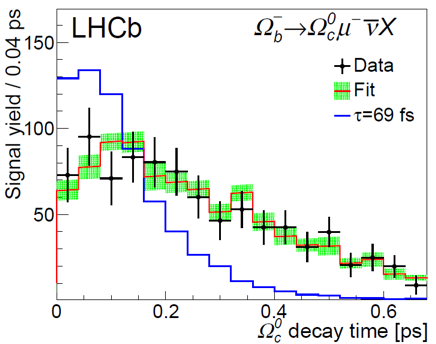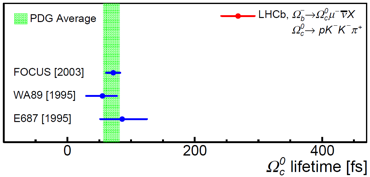[ τ(Ωc0) = 268±24±10±2 fs ]
Today the LHCb collaboration submitted for publication the result of a measurement of the lifetime of the Ωc0 baryon, i.e. a composite particle composed of css quarks. The Ωc0 baryon was identified via Ωb–→Ωc0μ–νμX decays, and then by means of the Ωc0→pK–K–π+ decay.
The decay-time distribution of the Ωc0 baryons reconstructed in the analysed sample was measured relative to that of D+ meson decays, whose corresponding distribution is shown in the left image above. The lifetime of the D+ meson is known to better than 1% precision. This approach allowed for significant reductions in the systematic uncertainty associated to the measurement. A similar technique was also used, for example, in the Ξcc++ lifetime measurement. The right image above shows the measured Ωc0 decay-time distribution marked as “Data”. The “Fit” distribution is created with the lifetime parameter adjusted to describe (fit) the data in the best possible way.
The measured lifetime value 268±24±10±2 fs is nearly four times larger than, and inconsistent with, the values measured by previous experiments, as visible in the image aside. The Ωc0 baryon lifetime was measured about 15-20 years ago by the Fermilab photoproduction experiments E687 and FOCUS and the CERN WA89 experiment located at the Σ– beamline of the SPS. The small samples of Ωc0 observed at the time were produced in collisions with nuclear targets. LHCb physicists analysed about 1000 Ωc0 baryon decays, which constitute a sample that is at least an order of magnitude larger than those used by previous experiments. The spectrum in the right image above labelled as “τ=69 fs” shows what LHCb physicists should have observed if the Ωc0 lifetime had the world average (PDG) value. The inconsistency is clearly visible.
It is rare that a new measurement of the properties of a known particle results in such a large difference compared to previous measurements. Since lifetime measurements of hadrons containing heavy quarks are sensitive to the internal structure and dynamics within those hadrons, today’s precision measurement by LHCb will stimulate even more interest in charmed-baryon lifetime measurements as well as renewed theoretical efforts to understand the internal structure of charmed baryons. Moreover, they will help us understand how to incorporate QCD effects into the calculations used to describe the decays of baryons containing heavy (b or c) quarks.
Read more in the LHCb publication, in the LHCb presentation at the 2018 Conference on Large Hadron Collider Physics, LHCP, in Bologna, and also in the CERN Update in English and French, in the CERN Courier article as well as in the Physics Today Research Update.



